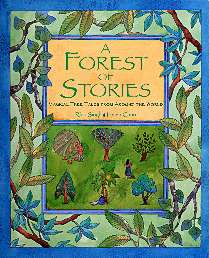 A Forest of Stories, by Rina Singh and Helen Cann, is a collection of “magical tree tales from around the world.” These folktales reign from China, Guatemala, Japan, India, Nigeria, Israel, and Morocco. As Rina explains in the introduction to A Forest of Stories,
A Forest of Stories, by Rina Singh and Helen Cann, is a collection of “magical tree tales from around the world.” These folktales reign from China, Guatemala, Japan, India, Nigeria, Israel, and Morocco. As Rina explains in the introduction to A Forest of Stories,
Trees are here with us now. We have a direct relationship with them-an unfair alliance, in which we accept a multitude of gifts from them and offer nothing in return. We nourish ourselves with the fruit they provide, and we use their wood to make our homes. We plant them in our gardens and parks, and we heal ourselves with the medicines they give us. We have both creatively and selfishly put every part of the tree to use, and yet they make no demands on us. they stand still, holding the soil in place, controlling floods and providing homes to countless animals.
Here is a list of the wonderful tree tales from A Forest of Stories:
- The Cypress Tree (Chinese)
- The Kapok Tree (Guatemalan)
- The Chestnut Tree (Japanese)
- The Cherry Blossom Tree (Indian)
- The Palm Tree (Nigerian)
- The Fig Tree (Jewish)
- The Pomegranate Tree (Moroccan)
My daughter’s favorite story is “The Chestnut Tree”, the tale of a Japanese girl named Aiko who is comforted by a tall chestnut tree on her way home from work everyday. One day, the tree tells her he is to be cut down and made into a great ship. Ironically, Aiko’s father drowned when his boat was hit by a large fishing vessel during a great storm.
Aiko is heartbroken when she discovers the chestnut tree’s stump, but she remembers its words that only she would be able to launch the great ship it by hugging it and saying, “I am Aiko, your friend.”
The prince comes to launch the great chestnut tree’s boat into the ocean, but it will not budge. All the strong fisherman tried to move the ship, but only Aiko had the power. In the end, the prince is enchanted by her story and asks her to marry him. “Her good fortune was indeed a gift of friendship from the chestnut tree.”
Why do so many stories end with strong women marrying princes?
Always on the look out for new quality literature for the kids. A beautiful picture book that we love is “One less fish by Kim Michelle Toft”
What reading level is this book?
John
Ages 9-12, however, I read it to my six-year-old, but she could not read it herself. I think the recommended age is for independent reading.
So glad that I found your web site. I will be following it. As a writer, author, and educator I am passionate about encouraging and teaching kids to become wise stewards of the natural environment. I have found that the best way to encourage this is: through field trips to the woods streams and seashores to experience the natural environment first hand. Teaching in the classroom to ensure that students understand and absorb scientific facts from related sciences so that can make informed, wise decisions. Reading kids literature with environmental themes to spur imagination and creativity.